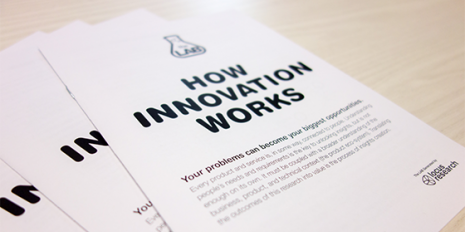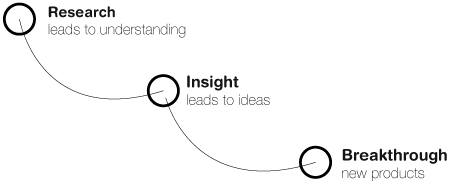
As a part of our contribution to the Fieldays Innovations and for use in the LAB, we created a resource under the broad title of 'How Innovation Works' and the resource focussed specifically on generating insight through research.
This resource focussed on people. Every product and service is, in some way, connected to people. Understanding people’s needs and requirements is the key to unlocking insights, but is not enough on its own. It must be coupled with a broader understanding of the business, product, and technical context (the product eco-system). Translating the outcomes of this research into value is the process of insights creation.
The perception of market research has been tarnished by lengthy surveys used to derive statistical results from large samples. However, the most effective and valuable market research is largely a qualitative process. It’s a combination of creative and analytical methodologies, which when done correctly, can unlock enormous value for your business.
Research also reduces risks. By committing to undertake a period of research at the start of your development project, you have a far greater chance of creating a breakthrough product or service. Research provides a clear direction and focus for the project; it reduces U-turns and blind alleys, and can highlight potential barriers for technical and commercial success.
This document sets out an approach to plan for insights and to conduct research. It provides guiding principles for primary research and how to interpret this data into valuable insights. This is the culmination of many years of work in the field, learning from others, and learning from experience. It serves as a guide and not a rigid process.
Our research approach is underpinned by a simple research loop:

Research is the data gathering phase and pulls in qualitative and quantitative information from a number of sources. This data and information needs to be synthesised so that it can be understood. Patterns, conflicts, and connections are made across the information to build an understanding of the full picture.
Insight is more likely gleaned based on this understanding and clarity. Some insights emerge with ease and others require coaxing through a series of techniques. Well-articulated insights are the starting point for generating ideas for products and or services that will lead to breakthrough solutions.
This simple research loop forms the foundation of our research process and can be applied both at the start of projects and throughout the product development process.
The process of turning research into insights is generalised by a four stage process:

Below is a framework to plan research activities. The key is to plan for insights and not just the gathering of research data. This framework is used to plan and clarify the scope and define the resources required to undertake the task at every stage. This information is captured in a one-page outline which is an effective communication tool for project stakeholders and provides clarity for the research team.
The synthesis and insight stages, where research is translated into insights, are energy intensive and often a challenging task. The work should be planned accordingly to allow sufficient time and resources, as this is where the value is created.

Objectives
These are the questions you are trying to answer – what do you need to know at this point in the product development process? The objectives should be relative to the scope of the project – an objective that is too broad will be unachievable.
Define the different research streams and determine the objectives for each. For example you may have a customer research stream, a technical research stream, and a competing product or market research stream.
Hypotheses
Begin by recording your hypotheses for each research stream. Hypotheses are the things you know and the things you think you know. These hypotheses will drive the research to query whether they are right or wrong assumptions. The research process will essentially test your understanding of your customers and the product eco-system.
For customer research, build hypotheses around the following aspects of your customer’s experience with the product or service you are researching:
During product development it is dangerous to assume these outcomes because this suggests you are proceeding with an unqualified opinion. Hypothesise, test, and understand instead.
Approach
Define the methodologies for how best to conduct the research. Selecting the most appropriate method(s) is important and is strongly related to the objective. Consider which is the best way to interrogate your hypotheses.
Research methods fall into four high level categories: observational, interviewing, surveying, and desk-top research. These can be deployed as separate methods or combined to gather more data. The details of each area are discussed in more detail in the Research section.
A. Observational research – watching and recording people’s behaviour in context;
B. Interviewing – meeting and questioning people about a contextual topic, they may be experts or customers;
C. Surveying – quantitative surveying can provide statistical metrics on predefined questions;
D. Desktop – predominantly web-based research drawing information from a wide range of media.
In the planning phase, use the framework to outline the specific details of the research sessions – build the action plan. Think about how you will access these people? Do you need to recruit? What are the recruitment criteria? Consider where the research should be undertaken – location can provide valuable insights into people’s natural (and most comfortable) environments. Where can you source technical and market information?
In this planning phase it is important to match the research to your project scope.
The amount of time, energy, and money that you invest in the research phase of a project should be proportionate to the degree of change that you are driving for. This affects the overall size and scope of the project. For fundamental breakthroughs, a large research base would be desirable to maximise your chances of uncovering new insights and developing breakthroughs. Conversely, even for small projects that perhaps are aimed at iterative development, a small targeted research phase will increase the project’s success, if managed and used effectively.
Research
This is the phase where you begin to capture the research data.
The most important question to answer during research is ‘why’. Why is someone saying what they are? Why is that person behaving how they do? Why are the technical issues occurring? Probe and interrogate during research sessions to get to this point. Angle the questions and lines of inquiry to understand ‘why’.
Synthesis
The goal of synthesis is to bring together and combine the information into a more connected whole and, by doing so, take a more holistic approach to assessment and analysis in order to make sense of the data you’ve gathered.
The research process will generate vast quantities of data and fragments of information that initially appear unrelated or disconnected and have to be interpreted and translated into useful information and valuable insights. This is often the most challenging part of the process but it holds the most value.
The synthesis stage makes sense of the masses of research data. It’s both a qualitative and analytical process that involves bringing the information together, clustering common connected or relating items that influence each other and then filtering, grouping, and organising. Work in groups quickly after the capture stage to understand the data while it is fresh. The longer you leave it the more you’ll lose the true meaning.
Interpretation
When the information from one or more of your research streams is complete and recorded, it’s time to start generating insights. This is best done in a small team session with all participants having a full understanding of the research findings prior to the session. The session will generate fundamental insights and ideas that can then be crafted into well-articulated and framed insight statements.
Frame Insights & Point of View Statements
Once you have identified the underlying problems, issues, and forces, frame these by writing a succinct problem statement for each – normally there is more than one, but a single statement is ok. With each problem statement, frame a point of view statement. This is about capturing your belief and point of view of the problem, why it’s really a problem, and then how this might be overcome. The goal here is to really cut to what you think is the core problem, the epicentre of it, and then frame your point of view for why it’s a problem. This will help you take a position. It also helps you to move from ‘information insights’ to ‘what if insights’ to further close your knowledge gaps.
What If Insights
With your point of view statements, it’s important to explore and define a series of ‘what if’ questions. ‘What if’ questions help you to look at the core problem differently and by doing so gain greater insight? With a series of ‘what if’ questions you can test your insights with more research. They will help you to better understand whether the core problems that you have identified are indeed accurate – your hypothesis of the problem – and whether your positioning point of view may offer new benefit.
In our experience the keys to successfully implementing an insightful research process are:
1. Plan your research to generate insights.
2. Leave the office and get in to place.
3. Use a range of methods, both qualitative and quantitative.
4. Get a mix of perspectives: internal and external; customer and expert.
5. Document all findings in usable form to build a rich resource.
Here is a selection of tools to use when conducting research:
1. Framework templates – use a series of templates to help plan and manage the research and ensure consistency across subjects and projects.
2. Notebook – don’t underestimate analogue. Scribble notes, draw pictures, develop, and review concepts real time.
3. Evernote – Digital tools such as Evernote are excellent for collection and management of research data. These can be used on the fly and can capture most mediums from photos to web clippings and notes. The mobile app means those follow-up thoughts are never lost on the journey home.
4. Camera – a camera is your best friend. It’s the tool that will capture a thousand words. Be curious and record the moment – it’s all part of the data-stream and if you don’t see something in the scene someone else might back at base.
5. Smart phone – the miniature computer in your pocket holds most of the research tools: a camera (still and video), notes, data collection apps, an audio recorder, and the communication line back to the team to share-back immediately after the research.
6. Spreadsheets – can be a good start point for collecting and sorting information.
7. Reports – capturing and chunking information as you go will help keep the focus and provides a useful resource.
Here is a list of guiding principles when conducting customer research:
The resource has been collectively put together by Blythe, Jono, Myself, Kat and collates our wide experiences across a number of domains.
Comments
Post new comment